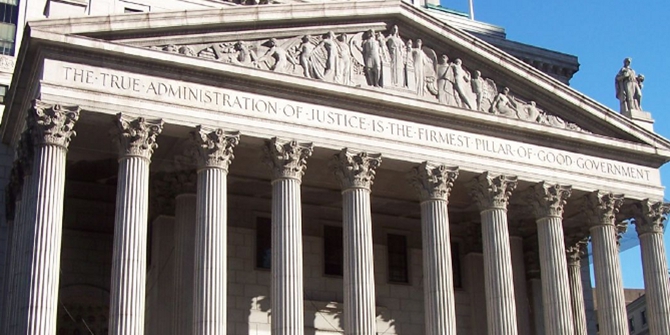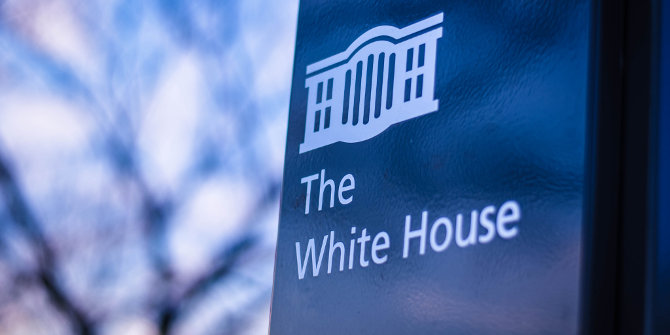
 The recent partisan blocking of President Obama’s moderate Supreme Court appointment, Judge Merrick Garland, was a new peak for a politicized Supreme Court. However, though this dangerous trend has been a long-term development, Michael Livermore and Daniel Rockmore argue that the trend is not irreversible and propose serious reforms to help tackle the dysfunctional Court’s politicization and remove the political stakes associated with its appointments.
The recent partisan blocking of President Obama’s moderate Supreme Court appointment, Judge Merrick Garland, was a new peak for a politicized Supreme Court. However, though this dangerous trend has been a long-term development, Michael Livermore and Daniel Rockmore argue that the trend is not irreversible and propose serious reforms to help tackle the dysfunctional Court’s politicization and remove the political stakes associated with its appointments.
The fight over Judge Neil Gorsuch’s nomination to the Supreme Court is the latest spectacle in a months-long political circus, following the Republican-controlled Senate’s refusal to hold hearings on President Obama’s nomination of Judge Merrick Garland. But this is only the most recent iteration of a politicized process that has been unfolding for decades. A combination of extensive media coverage, spending by ideological interest groups, and the partisan polarization of constitutional interpretation has turned Supreme Court nominations into unproductive mass political spectacles. The question is whether there are alternatives that can break this vicious cycle that undermines judicial independence and the legitimacy of both the Court and the political branches.
Democrats and Republicans have fallen into what game theorists call a “non-cooperative equilibrium,” in which each side seeks to punish the other for past bad behavior in an ever-descending spiral that benefits no one. The root of our current dysfunctional steady-state is found in the interaction of separation of powers and the highly polarized partisanship of today’s politics. As to the former, it is probably fair to assume that in order to maintain some semblance of public trust, Presidents and members of the Senate from both parties prefer that the Court maintain its reputation as a separate and independent branch of government able to make decisions on principled, rather than partisan, grounds. But this desire is at odds with the fact that the Court weighs in on many socially important issues with deep partisan cleavages, such as abortion, the relationship between church and state, and presidential power. Given that it is possible to at least roughly predict the judicial tendencies of potential Justices, it is natural for politicians to try to gain a policymaking ally on the Court. Effectively, the executive and legislative branches would like to have their Court and use it too.
Lifetime appointments of Justices
In the current polarized environment, the policy costs and benefits of confirmation battles are very high due, in part, to the lifetime appointment of Justices. Although life appointment has been around for a long time, its consequences have become more important as life expectancies have increased since 1789. The second major factor is that with increased polarization, the parties now have starkly different ideas of how Justices should decide many controversial questions. The high stakes of lifetime appointments, combined with extreme differences over many questions that come before the Court, ensures that politicians will have strong incentives to use every tool at their disposal to affect who gets confirmed, even if there are some costs to the Court’s institutional reputation and the popularity of the Senate and the President.
This incentive set maps onto separation of powers in particularly pernicious ways. One might think that separating nomination and confirmation authority between two bodies would promote moderation and compromise. If concern for institutional values was higher, or the political costs and benefits were lower, that might in fact be what occurred: Presidents would negotiate with the Senate on compromise candidates that enjoyed enough support from both parties to be confirmed by large majorities. In the past, this is often how the system worked: Justice Scalia was confirmed by a 98–0 Senate vote while Justices Ginsberg and Breyer were confirmed 96–3 and 87–9, respectively. More often than not, the right credentials (prestigious law school and clerkship, high-level appointments) and the Presidential imprimatur (after some vetting of course) were enough to allow the Senate to get behind the choice.
A ‘post-nuclear Senate’?
But that practice has broken down. During the most recent period of divided government, the Senate used its position to block even the nomination of the moderate Judge Merrick Garland. With the Republican party now controlling both the White House and the Senate, a candidate was proposed who had relatively little bipartisan appeal, and he was subsequently railroaded through by a party-line vote. Social norms of comity are so broken that the Republicans, egged on—if not ordered—by a belligerent White House, chose to make recourse to “the nuclear option” to secure Gorsuch’s confirmation. If the Democrats take back the Senate at some point during the Trump administration, one might expect them to take a similar approach; the new “post-nuclear” Senate could very well come back to haunt the Republicans in a new and more dangerous version of “tit-for-tat.”
It doesn’t have to be this way. We have tools to make changes if we wanted to. It is not obvious that institutions that made sense in the late eighteenth century continue to function well in the twenty-first. If both parties became dissatisfied with the functioning of the nomination process, reforms could occur. Congress has the latitude to make certain reforms via statute, while others may require a constitutional amendment. The latter is difficult, but far from impossible. The question is one of coalescing around an alternative and building the necessary political will. High levels of disgust with the current system provide a good starting point.
If we look around the world, other judicial systems sometimes update their appointment processes in their highest courts. For example, Prime Minister Justin Trudeau has changed how nominations to the Supreme Court of Canada are made. In fact, if we take the time to look abroad, we would discover that there is a vast diversity of judicial institutional arrangements, and some of those might suggest other arrangements. The highest court in India, for example, has 31 judicial positions (with 28 currently filled). These judges sit in panels rather than as a whole, akin to how the appellate federal courts operate in the United States, where the typical decision is rendered by a three-judge panel. The European Union has a complex process for selecting judges as well as informal norms that ensure some degree of regional representation on the European Court of Justice.
One way to reduce the political stakes of Supreme Court appointments would be to remove the decision from the President and the Senate altogether, treating positions on the Supreme Court as rotating temporary appointments from the broader pool of currently serving appellate judges in the federal courts. Justices’ terms could be fixed at some set limit; for example, it would be possible to stagger appointments to turn over one Justice every six months, resulting in four-and-a-half-year terms. Under this system, each half-year, one of the Justices would finish his or her term, and a new Justice would be drawn by some objective algorithm (e.g., at random, or by seniority) from the pool of roughly 180 lower-court judges to serve out a new term.
To some extent, it is possible that, under this system, the battleground would just shift to appointments to the federal appellate courts. Although this may happen, the reality is that adding a small chance of serving as a Supreme Court Justice for a few years would do very little to increase the stakes of these appointments. In fact, since most Justices are drawn from the federal appellate courts, the possibility that any given appointee may eventually serve on the Supreme Court is already built into the process. Further, there are so many of these appointments that it would be harder for the media, interest groups, and partisans to generate a firestorm each and every time.
This process also would serve to continually recharge the Court with new perspectives, and would add some regional, educational, and experiential diversity. In addition, it would avoid the stable (and destructive) ideological divide that now defines the Court, and which has made replacing Justice Scalia so contentious. Borrowing a lesson from biological processes, by adding a little random variation to the Court’s composition, this new process may also help enhance the diversity of the law, in the sense of adding alternative legal doctrines into the mix that would never have found their means of expression in a more rigid and less dynamic appointment process.
An additional advantage of our proposal is that it would tie the Supreme Court more closely to the everyday workings of the appellate courts. Over time, the Supreme Court has become highly specialized and distinctive, taking on a role that is more akin to a political institution (such as Congress) than to a typical judicial institution. In recent research, we analyzed the Supreme Court’s opinions using big data text analysis tools and found that over the past fifty years, the Supreme Court’s opinions have become increasingly idiosyncratic and less similar to the opinions of the federal appellate courts. The increasing politicization of Supreme Court nominations, coupled with the increasing distinctiveness of how the Court analyzes and writes about the legal cases before it, raise genuine questions about the long-term sustainability of the institution’s legitimacy.
There is no reason that Americans should accept the current sorry state of affairs. If the institutions currently given the responsibility of selecting Justices have lost the ability to perform this function in a responsible manner, we need to look for alternatives. At this point, our political institutions are failing so spectacularly that perhaps it is time to consider giving random selection a chance.
“New York County Supreme Court” by Dennis is licensed under CC BY-SA 2.0.
Please read our comments policy before commenting.
Note: This article gives the views of the author, and not the position of USAPP – American Politics and Policy, nor of the London School of Economics.
Shortened URL for this post: http://bit.ly/2q5HYiy
_________________________________
 Michael A. Livermore – University of Virginia
Michael A. Livermore – University of Virginia
Michael A. Livermore is an associate professor of law at the University of Virginia.
 Daniel Rockmore – Dartmouth College
Daniel Rockmore – Dartmouth College
Daniel Rockmore is a professor of mathematics and computer science at Dartmouth College.





And who was it that started the Nuclear Option?
Cary Michael Cox